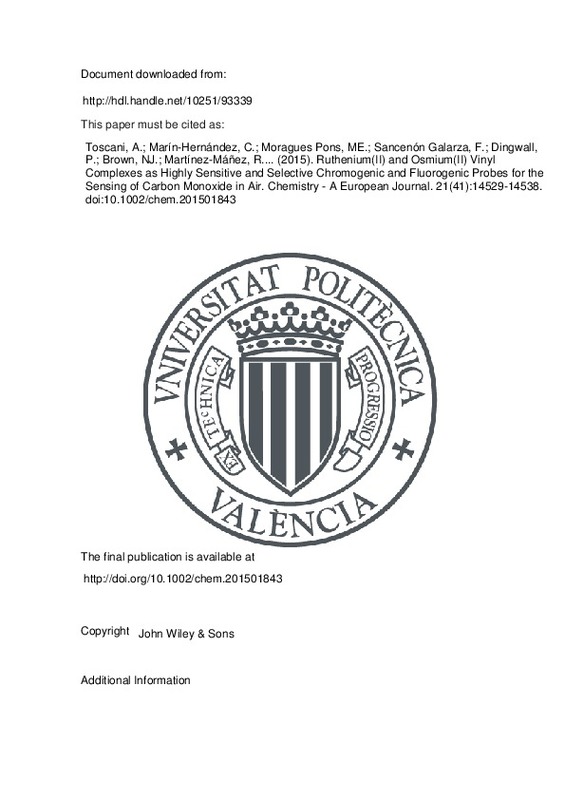JavaScript is disabled for your browser. Some features of this site may not work without it.
Buscar en RiuNet
Listar
Mi cuenta
Estadísticas
Ayuda RiuNet
Admin. UPV
Ruthenium(II) and Osmium(II) Vinyl Complexes as Highly Sensitive and Selective Chromogenic and Fluorogenic Probes for the Sensing of Carbon Monoxide in Air
Mostrar el registro sencillo del ítem
Ficheros en el ítem
| dc.contributor.author | Toscani, Anita
|
es_ES |
| dc.contributor.author | Marín-Hernández, Cristina
|
es_ES |
| dc.contributor.author | Moragues Pons, María Esperanza
|
es_ES |
| dc.contributor.author | Sancenón Galarza, Félix
|
es_ES |
| dc.contributor.author | Dingwall, Paul
|
es_ES |
| dc.contributor.author | Brown, Neil J.
|
es_ES |
| dc.contributor.author | Martínez-Máñez, Ramón
|
es_ES |
| dc.contributor.author | White, Andrew J. P.
|
es_ES |
| dc.contributor.author | Wilton-Ely, J.D.E.T.
|
es_ES |
| dc.date.accessioned | 2017-12-22T07:47:10Z | |
| dc.date.available | 2017-12-22T07:47:10Z | |
| dc.date.issued | 2015 | es_ES |
| dc.identifier.issn | 0947-6539 | es_ES |
| dc.identifier.uri | http://hdl.handle.net/10251/93339 | |
| dc.description.abstract | [EN] The detection of carbon monoxide in solution and air has been achieved using simple, inexpensive systems based on the vinyl complexes [M(CH=CHR)Cl(CO)(BTD)(PPh3)2] (R=aryl, BTD=2,1,3-benzothiadiazole). Depending on the nature of the vinyl group, chromogenic and fluorogenic responses signalled the presence of this odourless, tasteless, invisible, and toxic gas. Solutions of the complexes in CHCl3 underwent rapid change between easily differentiated colours when exposed to air samples containing CO. More significantly, the adsorption of the complexes on silica produced colorimetric probes for the naked-eye detection of CO in the gas phase. Structural data for key species before and after the addition of CO were obtained by means of single X-ray diffraction studies. In all cases, the ruthenium and osmium vinyl complexes studied showed a highly selective response to CO with exceptionally low detection limits. Naked-eye detection of CO at concentrations as low as 5 ppb in air was achieved with the onset of toxic levels (i.e., 100 ppm), thus resulting in a remarkably clear colour change. Moreover, complexes bearing pyrenyl, naphthyl, and phenanthrenyl moieties were fluorescent, and greater sensitivities were achieved (through turn-on emission fluorescence) in the presence of CO both in solution and air. This behaviour was explored computationally using time-dependent density functional theory (TDDFT) experiments. In addition, the systems were shown to be selective for CO over all other gases tested, including water vapour and common organic solvents. Supporting the metal complexes on cellulose strips for use in an existing optoelectronic device allows numerical readings for the CO concentration to be obtained and provision of an alarm system. | es_ES |
| dc.description.sponsorship | The authors wish to express their gratitude to the Spanish Government (project MAT2012-38429-C04) and Generalitat Valenciana (project PROMETEOII/2014/047) for their support. M.E.M. is grateful to the Spanish Ministerio de Ciencia e Innovacion for an FPU grant and a short-stay fellowship, which allowed this profitable collaboration. C.M.-H. thanks the Spanish Ministry of Economy and Competitiveness for her grant. A.T. gratefully acknowledges the support of the Leverhulme Trust (Grant RPG-2012-634) for a studentship. The authors thank Prof. C. K. Williams, Prof. N. J. Long, and Dr P. Hunt (Imperial College, UK) for the use of apparatus and assistance. | |
| dc.language | Inglés | es_ES |
| dc.publisher | John Wiley & Sons | es_ES |
| dc.relation.ispartof | Chemistry - A European Journal | es_ES |
| dc.rights | Reserva de todos los derechos | es_ES |
| dc.subject | Sensors | es_ES |
| dc.subject | Ruthenium | es_ES |
| dc.subject | Carbon monoxide | es_ES |
| dc.subject | Gas detection | es_ES |
| dc.subject | Osmium | es_ES |
| dc.subject.classification | QUIMICA INORGANICA | es_ES |
| dc.subject.classification | QUIMICA ORGANICA | es_ES |
| dc.subject.classification | QUIMICA ANALITICA | es_ES |
| dc.title | Ruthenium(II) and Osmium(II) Vinyl Complexes as Highly Sensitive and Selective Chromogenic and Fluorogenic Probes for the Sensing of Carbon Monoxide in Air | es_ES |
| dc.type | Artículo | es_ES |
| dc.identifier.doi | 10.1002/chem.201501843 | es_ES |
| dc.relation.projectID | info:eu-repo/grantAgreement/MINECO//MAT2012-38429-C04-01/ES/DESARROLLO DE MATERIALES FUNCIONALIZADOS CON PUERTAS NANOSCOPICAS PARA APLICACIONES DE LIBERACION CONTROLADA Y SENSORES PARA LA DETECCION DE NITRATO AMONICO, SULFIDRICO Y CO/ | es_ES |
| dc.relation.projectID | info:eu-repo/grantAgreement/GVA//PROMETEOII%2F2014%2F047/ES/Nuevas aproximaciones para el diseño de materiales de liberación controlada y la detección de compuestos peligrosos/ | es_ES |
| dc.relation.projectID | info:eu-repo/grantAgreement/Leverhulme Trust//RPG-2012-634/ | |
| dc.rights.accessRights | Abierto | es_ES |
| dc.contributor.affiliation | Universitat Politècnica de València. Departamento de Química - Departament de Química | es_ES |
| dc.description.bibliographicCitation | Toscani, A.; Marín-Hernández, C.; Moragues Pons, ME.; Sancenón Galarza, F.; Dingwall, P.; Brown, NJ.; Martínez-Máñez, R.... (2015). Ruthenium(II) and Osmium(II) Vinyl Complexes as Highly Sensitive and Selective Chromogenic and Fluorogenic Probes for the Sensing of Carbon Monoxide in Air. Chemistry - A European Journal. 21(41):14529-14538. https://doi.org/10.1002/chem.201501843 | es_ES |
| dc.description.accrualMethod | S | es_ES |
| dc.relation.publisherversion | http://doi.org/10.1002/chem.201501843 | es_ES |
| dc.description.upvformatpinicio | 14529 | es_ES |
| dc.description.upvformatpfin | 14538 | es_ES |
| dc.type.version | info:eu-repo/semantics/publishedVersion | es_ES |
| dc.description.volume | 21 | es_ES |
| dc.description.issue | 41 | es_ES |
| dc.identifier.pmid | 26270512 | |
| dc.relation.pasarela | S\294213 | es_ES |
| dc.contributor.funder | Generalitat Valenciana | es_ES |
| dc.contributor.funder | Ministerio de Economía y Competitividad | es_ES |
| dc.contributor.funder | Leverhulme Trust | |
| dc.contributor.funder | Ministerio de Ciencia e Innovación | |
| dc.contributor.funder | European Regional Development Fund |







![[Cerrado]](/themes/UPV/images/candado.png)

